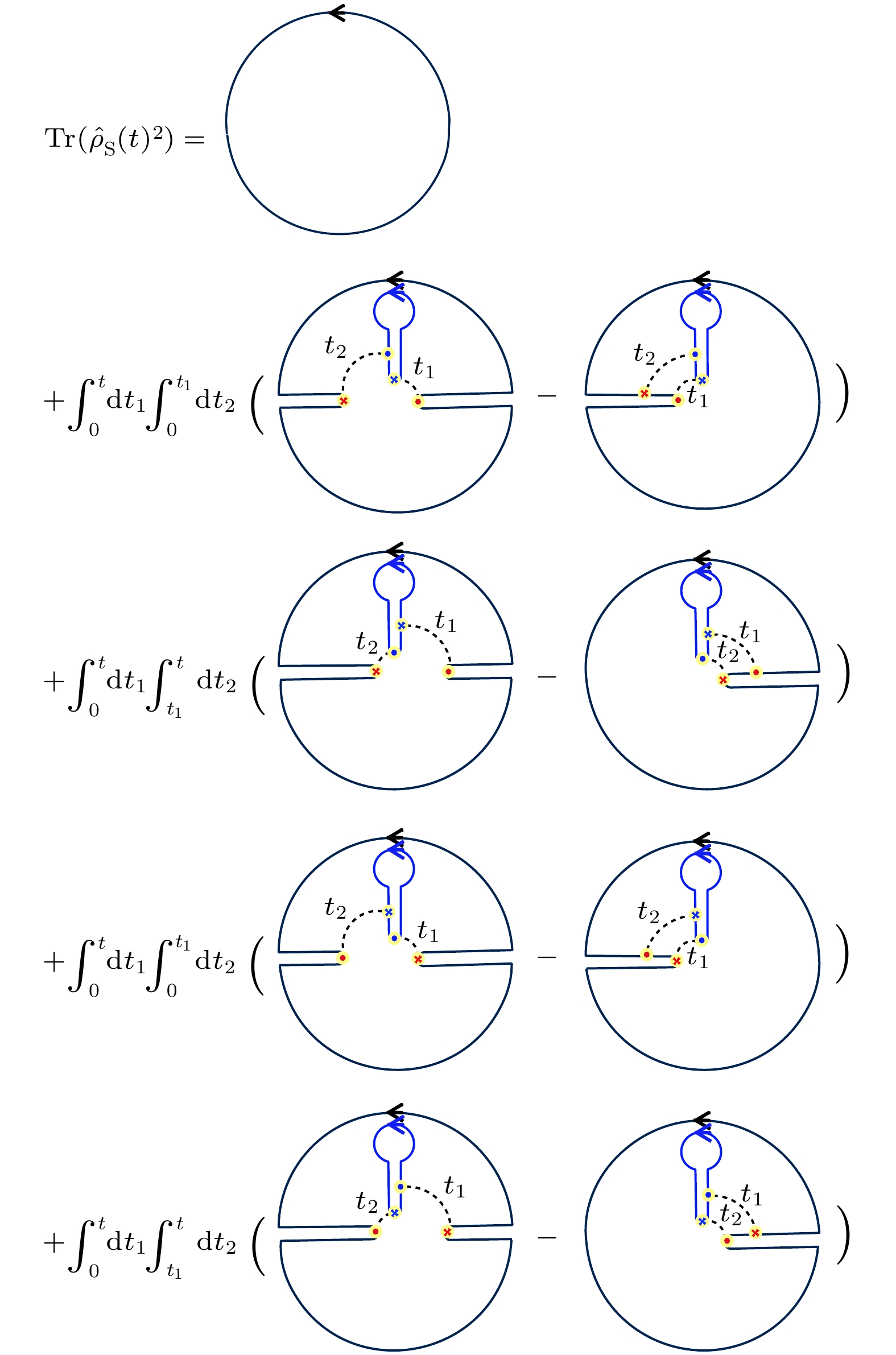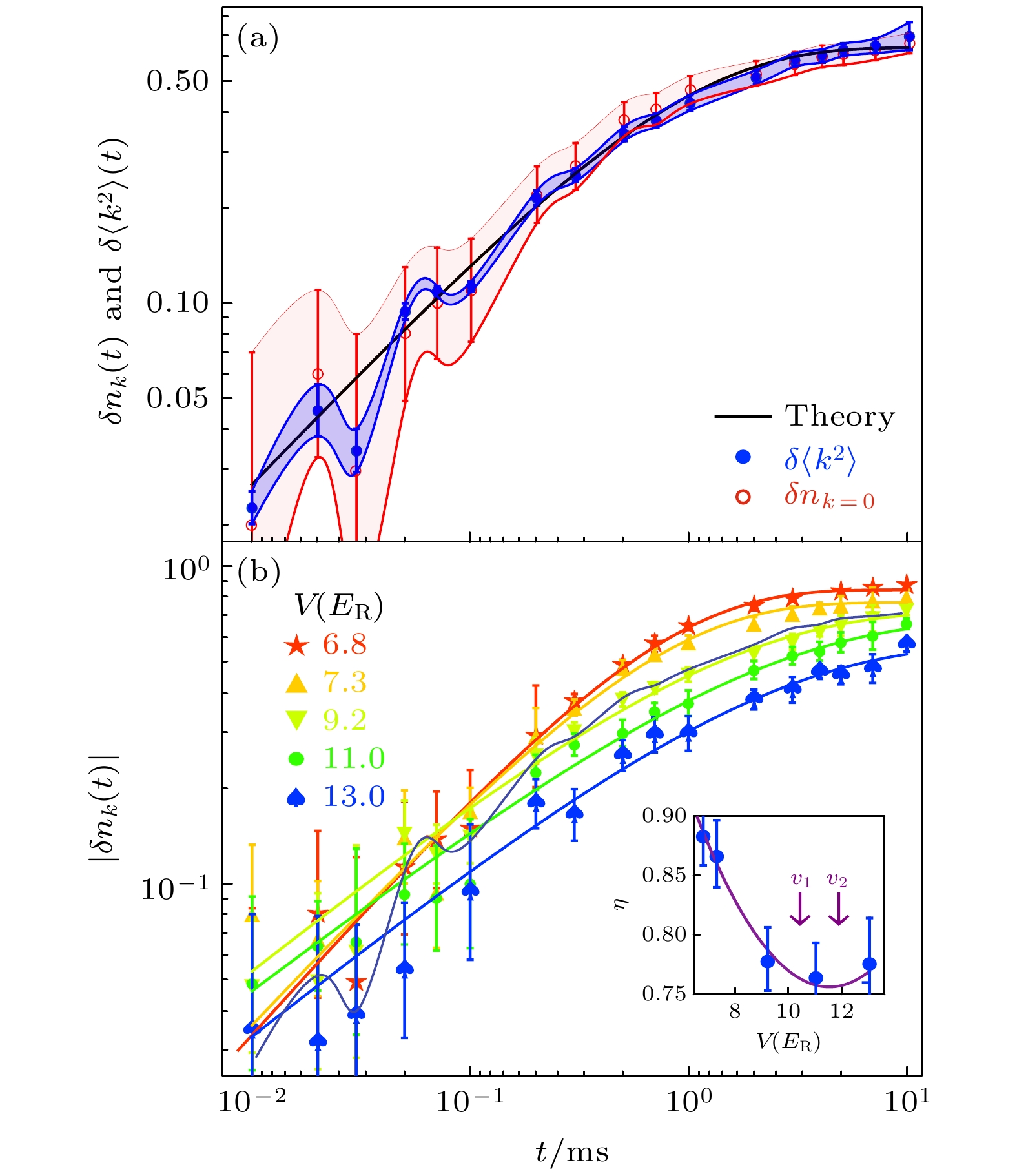-
近些年来, 随着实验技术的进步, 对量子多体系统的耗散控制能力得到了增强, 同时耗散动力学过程表征技术方面的实验也有了较大进展. 实验上的进展驱使我们在理论上建立量子多体系统的耗散动力学计算体系. 最近我们发现, 通过把系统和环境之间的相互作用看成对系统的一个微扰, 可以得到一般性的耗散响应理论. 通过这一响应理论, 可以回答物理可观测量以及熵在耗散下一定时间尺度内的动力学演化的问题. 本文建立了非Markov 环境下的一般理论, 并讨论了何时可以取到 Markov 近似, 同时综述了这种方法在计算强关联体系的耗散动力学、强相互作用开放体系的熵的动力学演化等方面的应用.With the recent development of experimental technology, the ability to control the dissipation in quantum many-body system is greatly enhanced. Meanwhile, many new breakthroughs are achieved in detecting the quantum states and others. All these advances make it necessary to establish a new theory for calculating the dissipative dynamics in strongly correlated sstems. Very recently, we found that by taking the interactions between the system and the bath as a perturbation, a systematic dissipative response theory can be established. In this new approach, the calculation of dissipative dynamics for any physical observables and the entropies can be converted into the calculation of certain correlation functions in initial states. Then we discuss how Markovian approximation at low temperature limit and at high temperature limit can be reached Also, we review the progress of the dissipative dynamics in open Bose-Hubbard model. In the fourth section, we review recent progress of entropy dynamics of quench dynamics of an open quantum system. Finally, we draw a conclusion and discuss possible development in the future.
-
Keywords:
- dissipative linear response theory /
- Markovian approximation /
- open quantum systems /
- entropy
[1] Mahan G D 1981 Many Particle Physics (New York and London: Plenum Press)
[2] Pan L, Chen X, Chen Y, Zhai H 2020 Nat. Phys. 16 767
 Google Scholar
Google Scholar
[3] Chen Y 2021 JHEP 04 215
[4] Feynman R P, Vernon Jr F L 1963 Ann. Phys. 24 118
 Google Scholar
Google Scholar
[5] Caldeira A O, Leggett A J 1983 Phys. A 121 587
 Google Scholar
Google Scholar
[6] Bouganne R, Aguilera M B, Ghermaoui A, Beugnon J, Gerbier F 2020 Nat. Phys. 16 21
 Google Scholar
Google Scholar
[7] Syassen N, Bauer D M, Lettner M, Volz T, Dietze D, GarcÍa- ripoll J J, Cirac J I, Rempe G, Dürr S 2008 Science 320 1329
[8] Barontini G, Labouvie R, Stubenrauch F, Vogler A, Guarrera V, Ott H 2013 Phys. Rev. Lett. 110 035302
 Google Scholar
Google Scholar
[9] Tomita T, Nakajima S, Danshita I, Takasu Y, Takahashi Y 2017 Sci. Adv. 99 e1701513
[10] Sponselee K, Freystatzky L, Abeln B, Diem M, Hundt B, Kochanke A, Ponath T, Santral B, Mathey L, Sengstock K, and Becker C 2018 Quantum Sci. Technol. 4 014002
 Google Scholar
Google Scholar
[11] Li J, Harter A K, Liu J, de Moel L, Joglekar Y N, Luo L 2019 Nat. Commun. 10 855
 Google Scholar
Google Scholar
[12] Tomita T, Nakajima S, Takasu Y, Takahashi Y 2019 Phys. Rev. A 99 031601
 Google Scholar
Google Scholar
[13] Cai Z, Barthel T 2013 Phys. Rev. Lett. 111 150403
 Google Scholar
Google Scholar
[14] Poletti D, Barmettler P, Georges A, Kollath C 2013 Phys. Rev. Lett. 111 195301
 Google Scholar
Google Scholar
[15] Sachdev S 1999 Quantum Phase Transitions (Cambridge: Cambridge University Press)
[16] Bardeen J M, Carter B, Hawking S 1973 Commun. Math. Phys. 31 161
 Google Scholar
Google Scholar
[17] Hawking S 1971 Phys. Rev. Lett. 26 1344
 Google Scholar
Google Scholar
[18] Hawking S 1974 Nature 248 30
 Google Scholar
Google Scholar
[19] Hawking S 1975 Commun. Math. Phys. 43 199
 Google Scholar
Google Scholar
[20] Christodoulou D 1970 Phys. Rev. Lett. 25 1596
 Google Scholar
Google Scholar
[21] Christodoulou D, Ruffini R 1971 Phys. Rev. D 4 3552
 Google Scholar
Google Scholar
[22] Bekenstein J D 1972 Lett. Nuovo Cimento 4 737
 Google Scholar
Google Scholar
[23] Bekenstein J D 1973 Phys. Rev. D 7 2333
[24] Hawking S 1976 Phys. Rev. D 14 2460
 Google Scholar
Google Scholar
[25] Page D N 1993 Phys. Rev. Lett. 71 3743
 Google Scholar
Google Scholar
[26] Strominger A, Vafa C 1996 Phys. Lett. B 379 99
 Google Scholar
Google Scholar
[27] Dabholkar A, Gomes J, Murthy S 2015 JHEP 03 074
[28] Gubser S S, Klebanov I R, Polyakov A M 1998 Phys. Lett. B 428 105
 Google Scholar
Google Scholar
[29] Witten E 1998 Adv. Theor. Math. Phys. 2 253
 Google Scholar
Google Scholar
[30] Maldacena J 1999 Int. J. Theor. Phys. 38 1113
 Google Scholar
Google Scholar
[31] Kitaev A talk at KITP 2015 http://online.kitp.ucsb.edu/online/entangled15/kitaev/ [2021-9-1]
[32] Kitaev A talk at KITP 2015 http://online.kitp.ucsb.edu/online/entangled15/kitaev2/ [2021-9-1]
[33] Ye J, Sachdev S 1993 Phys. Rev. Lett. 70 3339
 Google Scholar
Google Scholar
[34] Maldacena J, Stanford D 2016 Phys. Rev. D 94 106002
 Google Scholar
Google Scholar
[35] Kitaev A, Suh S J 2018 JHEP 05 183
[36] Maldacena J, Stanford D, Yang Z 2016 PTEP 2016 12C104
[37] Jakiw R 1985 Nucl. Phys. B 252 343
 Google Scholar
Google Scholar
[38] Teitelboim C 1983 Phys. Lett. B 126 41
 Google Scholar
Google Scholar
[39] Gross D J, Rosenhaus V 2017 JHEP 05 092
[40] Gu Y, Lucas A, Qi X L 2017 JHEP 09 120
[41] Huang Y, Gu Y 2017 Phys. Rev. D 100 041901
[42] Liu C, Chen X, Balents L 2018 Phys. Rev. B 97 245126
 Google Scholar
Google Scholar
[43] Zhang P 2019 Phys. Rev. B 100 245104
 Google Scholar
Google Scholar
[44] Chen Y, Qi X L, Zhang P 2020 JHEP 06 121
[45] Zhang P, Liu C, Chen X 2020 SciPost Phys. 8 094
 Google Scholar
Google Scholar
[46] Qi X L, Zhang P 2020 JHEP 05 129
[47] Haldar A, Bera S, Banerjee S 2020 Phys. Rev. Res. 2 033505
 Google Scholar
Google Scholar
[48] Zhang P 2020 JHEP 06 143
[49] Penington G 2020 JHEP 09 002
[50] Almheiri A, Engelhardt N, Marolf D, Maxfield H 2019 JHEP 12 063
[51] Almheiri A, Mahajan R, Maldacena J, Zhao Y 2020 JHEP 03 149
[52] Dadras P, Kitaev A 2021 JHEP 03 198
[53] Su K, Zhang P, Zhai H 2021 JHEP 06 156
-
图 4 (a)红色为0动量粒子数衰变的数据, 蓝色为动量空间中的粒子数宽度随时间变化的曲线; (b)拟合的不同晶格强度下的Bose-Hubbard模型中的0动量粒子数衰变曲线中的参数
$ \eta $ . 这里的反常维度应该在量子临界点处最小. 图(b)的小图里两个箭头所在的晶格强度就是量子临界点所在的位置[2]Fig. 4. (a) Red curve shows the decay of zero momentum particle occupation. The blue curve shows how the width of particle momentum distribution evolutes over time. The solid line is our theoretical prediction. (b) Theoretical curve with experimental data for zero momentum particle decay for different parameters. In the inset figure, we shows the anomalous dimension eta extracted from experimental data and we can see its minimal being around quantum critical region[2].
图 5 当环境比SYK系统温度高时系统的熵随时间的变化 (a)环境和系统的谱函数; (b)系统的熵随时间的演化, 可以看到经过初期的平方增长后变为线性增大. 系统的温度
$ \beta =10 $ , 相互作用强度$ J=4 $ ; 环境温度$ {\beta }_{\mathrm{E}}=2 $ , 相互作用强度$J'=8$ . 该图引用自文献[3]Fig. 5. (a)Spectral functions of the environment and the system; (b) entropy dynamics after the quench interaction between the system and the environment. Here the temperature of the environment is higher than the system’s initial temperature. The entropy dynamics shows a typical thermalization case. Cited from Ref. [3].
图 6 (a)系统的谱和环境的谱; (b)“黑洞蒸发”的熵的变化图. 系统的温度
$ \beta =2 $ , 相互作用强度$ J=2 $ ; 环境的温度$ {\beta }_{\mathrm{E}}=20 $ , 相互作用强度${J}'=2$ . 该图引自文献[3]Fig. 6. (a) Spectral functions of the environment and the system; (b) entropy dynamics after the quench interaction between the system and the environment. Here the temperature of the environment is lower than the system’s initial temperature. The entropy dynamics shows a typical cooling case. Here it can be compared with “Black Hole Evaporation” and the entropy dynamics looks like a Page curve. Cited from Ref. [3].
-
[1] Mahan G D 1981 Many Particle Physics (New York and London: Plenum Press)
[2] Pan L, Chen X, Chen Y, Zhai H 2020 Nat. Phys. 16 767
 Google Scholar
Google Scholar
[3] Chen Y 2021 JHEP 04 215
[4] Feynman R P, Vernon Jr F L 1963 Ann. Phys. 24 118
 Google Scholar
Google Scholar
[5] Caldeira A O, Leggett A J 1983 Phys. A 121 587
 Google Scholar
Google Scholar
[6] Bouganne R, Aguilera M B, Ghermaoui A, Beugnon J, Gerbier F 2020 Nat. Phys. 16 21
 Google Scholar
Google Scholar
[7] Syassen N, Bauer D M, Lettner M, Volz T, Dietze D, GarcÍa- ripoll J J, Cirac J I, Rempe G, Dürr S 2008 Science 320 1329
[8] Barontini G, Labouvie R, Stubenrauch F, Vogler A, Guarrera V, Ott H 2013 Phys. Rev. Lett. 110 035302
 Google Scholar
Google Scholar
[9] Tomita T, Nakajima S, Danshita I, Takasu Y, Takahashi Y 2017 Sci. Adv. 99 e1701513
[10] Sponselee K, Freystatzky L, Abeln B, Diem M, Hundt B, Kochanke A, Ponath T, Santral B, Mathey L, Sengstock K, and Becker C 2018 Quantum Sci. Technol. 4 014002
 Google Scholar
Google Scholar
[11] Li J, Harter A K, Liu J, de Moel L, Joglekar Y N, Luo L 2019 Nat. Commun. 10 855
 Google Scholar
Google Scholar
[12] Tomita T, Nakajima S, Takasu Y, Takahashi Y 2019 Phys. Rev. A 99 031601
 Google Scholar
Google Scholar
[13] Cai Z, Barthel T 2013 Phys. Rev. Lett. 111 150403
 Google Scholar
Google Scholar
[14] Poletti D, Barmettler P, Georges A, Kollath C 2013 Phys. Rev. Lett. 111 195301
 Google Scholar
Google Scholar
[15] Sachdev S 1999 Quantum Phase Transitions (Cambridge: Cambridge University Press)
[16] Bardeen J M, Carter B, Hawking S 1973 Commun. Math. Phys. 31 161
 Google Scholar
Google Scholar
[17] Hawking S 1971 Phys. Rev. Lett. 26 1344
 Google Scholar
Google Scholar
[18] Hawking S 1974 Nature 248 30
 Google Scholar
Google Scholar
[19] Hawking S 1975 Commun. Math. Phys. 43 199
 Google Scholar
Google Scholar
[20] Christodoulou D 1970 Phys. Rev. Lett. 25 1596
 Google Scholar
Google Scholar
[21] Christodoulou D, Ruffini R 1971 Phys. Rev. D 4 3552
 Google Scholar
Google Scholar
[22] Bekenstein J D 1972 Lett. Nuovo Cimento 4 737
 Google Scholar
Google Scholar
[23] Bekenstein J D 1973 Phys. Rev. D 7 2333
[24] Hawking S 1976 Phys. Rev. D 14 2460
 Google Scholar
Google Scholar
[25] Page D N 1993 Phys. Rev. Lett. 71 3743
 Google Scholar
Google Scholar
[26] Strominger A, Vafa C 1996 Phys. Lett. B 379 99
 Google Scholar
Google Scholar
[27] Dabholkar A, Gomes J, Murthy S 2015 JHEP 03 074
[28] Gubser S S, Klebanov I R, Polyakov A M 1998 Phys. Lett. B 428 105
 Google Scholar
Google Scholar
[29] Witten E 1998 Adv. Theor. Math. Phys. 2 253
 Google Scholar
Google Scholar
[30] Maldacena J 1999 Int. J. Theor. Phys. 38 1113
 Google Scholar
Google Scholar
[31] Kitaev A talk at KITP 2015 http://online.kitp.ucsb.edu/online/entangled15/kitaev/ [2021-9-1]
[32] Kitaev A talk at KITP 2015 http://online.kitp.ucsb.edu/online/entangled15/kitaev2/ [2021-9-1]
[33] Ye J, Sachdev S 1993 Phys. Rev. Lett. 70 3339
 Google Scholar
Google Scholar
[34] Maldacena J, Stanford D 2016 Phys. Rev. D 94 106002
 Google Scholar
Google Scholar
[35] Kitaev A, Suh S J 2018 JHEP 05 183
[36] Maldacena J, Stanford D, Yang Z 2016 PTEP 2016 12C104
[37] Jakiw R 1985 Nucl. Phys. B 252 343
 Google Scholar
Google Scholar
[38] Teitelboim C 1983 Phys. Lett. B 126 41
 Google Scholar
Google Scholar
[39] Gross D J, Rosenhaus V 2017 JHEP 05 092
[40] Gu Y, Lucas A, Qi X L 2017 JHEP 09 120
[41] Huang Y, Gu Y 2017 Phys. Rev. D 100 041901
[42] Liu C, Chen X, Balents L 2018 Phys. Rev. B 97 245126
 Google Scholar
Google Scholar
[43] Zhang P 2019 Phys. Rev. B 100 245104
 Google Scholar
Google Scholar
[44] Chen Y, Qi X L, Zhang P 2020 JHEP 06 121
[45] Zhang P, Liu C, Chen X 2020 SciPost Phys. 8 094
 Google Scholar
Google Scholar
[46] Qi X L, Zhang P 2020 JHEP 05 129
[47] Haldar A, Bera S, Banerjee S 2020 Phys. Rev. Res. 2 033505
 Google Scholar
Google Scholar
[48] Zhang P 2020 JHEP 06 143
[49] Penington G 2020 JHEP 09 002
[50] Almheiri A, Engelhardt N, Marolf D, Maxfield H 2019 JHEP 12 063
[51] Almheiri A, Mahajan R, Maldacena J, Zhao Y 2020 JHEP 03 149
[52] Dadras P, Kitaev A 2021 JHEP 03 198
[53] Su K, Zhang P, Zhai H 2021 JHEP 06 156
计量
- 文章访问数: 8863
- PDF下载量: 356
- 被引次数: 0














 下载:
下载:














